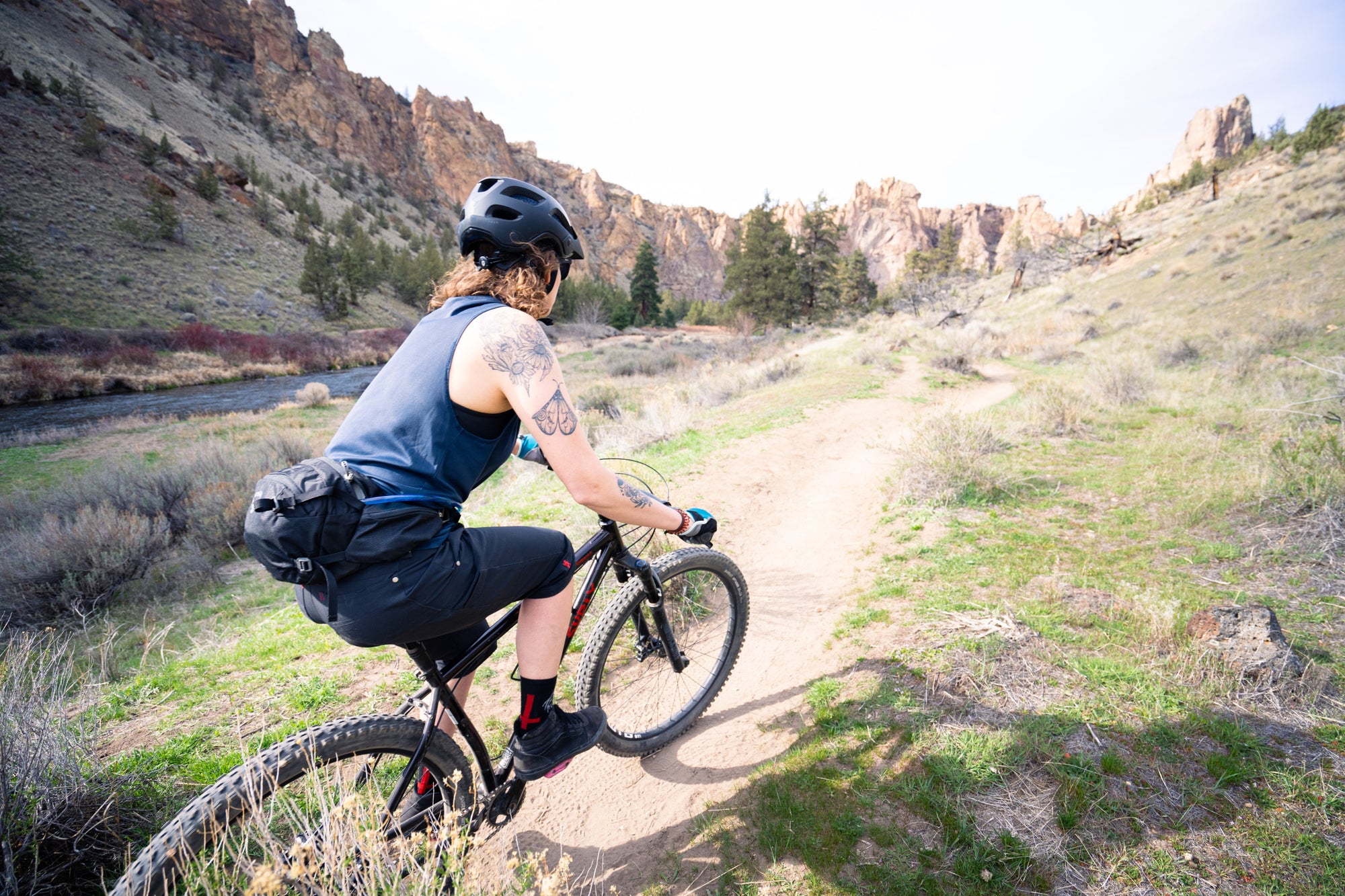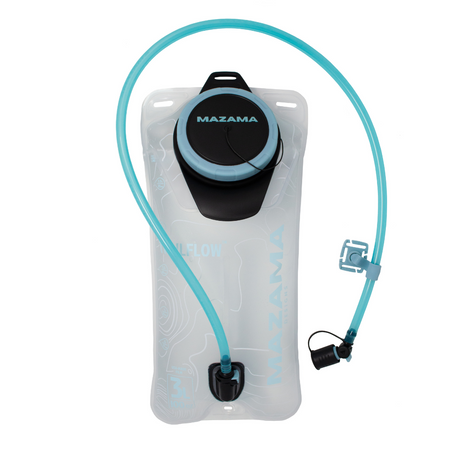Hydration Backpacks vs. Hydration Hip Packs: How to Choose a Pack for Your Mountain Bike Adventures
April 25 2022 – Matt Hoskins

You’ve probably noticed the resurgence of fanny packs — especially in the world of mountain biking. They’re more than a fashion statement. Hip packs today are increasingly leading edge and are used for all kinds of activities in the outdoor world. That doesn’t mean that backpacks are old news — in fact, there are plenty of situations when a waist pack just won’t do.
At Mazama, we spend a lot of time on our mountain bikes, where backpacks and hip packs both have their place. If you’re a mountain biker too, you may be undecided as to which is best for you.

So, how do you choose the best pack for your ride? There are lots of considerations to think about when choosing between a hydration hip pack and a hydration backpack. Both have their merits, which we’ll cover later on. But start by thinking about your rides, your needs, and your local climate so you can get an idea of the features you’re looking for.
Here are some things to consider:
With these considerations in mind, let’s dive into the pros and cons of lumbar hip packs versus backpack hydration packs.
Hydration Hip Packs

Hip packs, waist packs, lumbar packs, fanny packs — whatever you call them, they rest on your waist and are usually smaller than a backpack. Here are some common pros and cons involving the features of a hip pack.
Hip pack pros
- A waist pack sits lower on your torso and takes the weight off your shoulders. This lowers your center of gravity which gives you more control on your bike.
- Waist packs solve the problem of an unpleasant, sweaty back. Even the most breathable backpacks make it hard for your back to breathe when you’re working hard, and a waist pack can help keep you cool in hot weather.
- Since they’re smaller, waist packs are lighter and often less obtrusive than backpacks. Lots of riders love having more mobility in their shoulders and arms, and some simply find them more comfortable.
- Some riders find waist packs much more accessible than backpacks. You don’t have to take off your pack every time you need to access your gear — instead, you can reach behind or twist the pack so it’s within easy reach.
Hip pack cons
- Some riders don’t like the feeling of a waist belt. If it’s too tight, it’s uncomfortable. But if it’s too loose, it can slide around.
- Without the extra security of shoulder straps keeping your pack in place, waist packs tend to bounce around more than backpacks especially if they are fully loaded or are not worn tightly.
- Waist packs generally have a smaller capacity than a hydration backpack, so you’re limited to what you can bring. For quick rides in fair weather, that might not be an issue. But if you have to pack lots of water, snacks, or extra layers, you may not have the space in a hip pack.
- Fluid delivery from a lumbar hydration pack isn’t quite as effortless as a backpack hydration system. You’re working harder against gravity with a pack that sits lower on your torso.
- The drink tube is typically tethered on your waistbelt, so it's not as accessible as a shoulder-mounted tube and it can be dropped if you're not careful.
Backpack

They may currently be overshadowed by the trendier, more lightweight hip pack, but you can’t underestimate the power of a good backpack. Here are some common pros and cons of biking with a backpack.
Backpack pros
- Likely the most obvious benefit of choosing a backpack over a hip pack is the extra capacity you have to carry more gear. When the day starts cold and you need to shed layers as it heats up, you’ll have enough space to stash your extra layers.
- Capacity doesn’t just matter when it comes to your layers — you need to have space for other essentials, too. If you’re going on a particularly long ride, you may need more food and water than you can fit in a hip pack.
- Drinking efficiency is better in a backpack hydration system than in a lumbar system.
- While there are a variety of hip packs to choose from, there’s a wider range of backpacks on the market. You have a lot of choice when it comes to the specific features you want in a backpack as well as the capacity.
- Some bikers think backpacks, with their shoulder straps and hip belt, feel more secure than a hip pack.
- A backpack can help protect a rider's back during falls
Backpack cons
- A backpack, on its own, is usually heavier than a hip pack.
- With more capacity for gear, the more we tend to fill it. This means you’ll likely be carrying more weight around if you choose a backpack over a hip pack — regardless of what you actually need.
- While some backpacks do offer great ventilation, you’ll almost certainly feel sweatier with a backpack than a hip pack.
- Some people simply don’t like the feeling of shoulder straps — and for some, it bothers their neck and back. Straps can chafe and restrict movement depending on the fit.
How to Choose a Hydration Pack
Ready to shop for a hydration pack you can use on the trail? As you now know, there are plenty of pros and cons for both backpack hydration systems and waist pack hydration systems.
As you begin to shop around, keep in mind those considerations we started with, and begin to rate each of these aspects in terms of what’s most important and relevant to you. Here are a few other questions to ask yourself to help guide your purchase:
- Comfort--what feels most comfortable to wear?
- Breathability--are you looking to minimize how much you're wearing
- Performance--is fast and light your preferred mode?
- Ride duration--do your typical rides require extra water and cargo?
- Riding environment--do temperature fluctuations result in clothing changes as you ride?
- Hydration--is drinking on the move an important feature?
- Safety--what's your comfort level regarding having extra supplies and safety aids along with you during rides?
If your priorities are riding light and staying cool, a waist pack might be for you. But if you're rides are 3+ hours in varied temps or if you’re concerned about safety — having enough water, layers, and a well-stocked emergency kit — you might need to shop for a backpack.
After you settle on the type of hydration pack you're interested, other considerations include:
- What is the right size of hip pack or backpack for my use? Can this pack expand to hold more gear?
- Do I want a versatile pack or a specialized one? What else, if anything, will I use it for?
- How much do different types of packs cost? What is my budget?
- Do I want a pack that keeps all of my gear organized, or do I prefer a simple design?
- Does the pack include a reservoir?
- Does the pack have built in insulation to protect the hydration system? Do I ride in weather conditions where that’s something I need?
- Do I want a pack that can hold my gear — like my helmet — after my ride or between laps?

It all comes down to what you want and what you need. There’s no right pack for everyone — we all ride different trails, have different priorities, and live in different climates. The good news is, there are plenty of options whether you’re Team Waist Pack or Team Backpack. Whatever your style, we know you’ll find the right pack to get you out on the trail comfortably.
Mazama's new 1.5 L INTAKE Lumbar Reservoir--easy fill-up and taste-free drinking and sized to fit most hip packs


